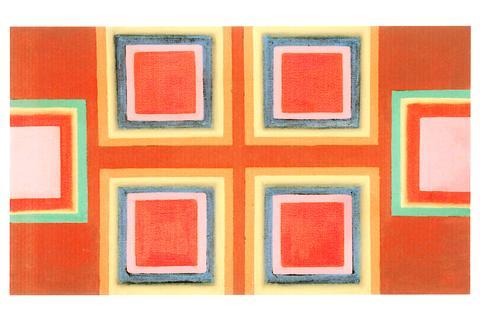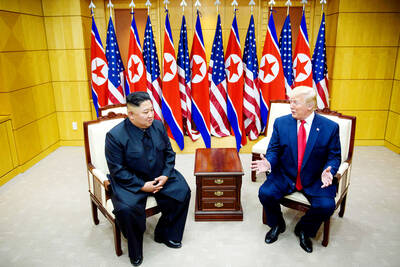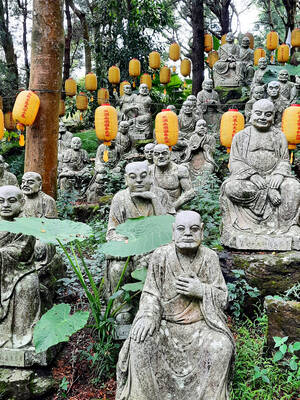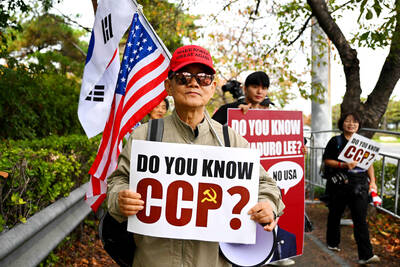Walking around the geometric abstraction exhibition at the Taipei Fine Arts Museum, one explores the varieties of Taiwanese abstract art, as well as examining the melding of Western concepts with Eastern philosophy that created a unique movement in Taiwan.
The Lyricism of Form: Geometric Abstraction highlights more than 50 pieces from 14 Taiwanese artists and spans the history of the movement in Taiwan from its onset in the 1960s to the present day.

Near the entrance of the exhibition is Chen Shiu-ming's (
Hu Kun-jung's (
Artists such as Richard Lin (
Images of folk art are also rich in Shiy De Jinn's (
From a postmodern perspective, Chang Cheng-jen (
When viewed as a whole, there doesn't seem to be a common thread underlining the exhibit, nor is it arranged in any particular order, chronological or otherwise. It does, however, examine the numerous influences -- both Western and Chinese -- that lead to a variegated abstract movement in Taiwan. The exhibit also provides an impressive overview of the group of artists who constructed the movement.
Equally interesting is how these pieces, which were originally influenced by works from the late 19th century, have become commonplace, mass-produced interior designs in bars, clubs and local homeware stores around the globe.
Exhibition notes:
What: The Lyricism of Form: Geometric Abstraction
Where: Taipei Fine Arts Museum (台北市立美術館) 181 Zhongshan N Rd, Sec 3, Taipei (臺北市中山北路3段181號).
Telephone: (02) 2595 7656
When: Until Oct. 10, Tuesday to Sunday from 9:30am to 5:30pm. Closed on Mondays

US President Donald Trump may have hoped for an impromptu talk with his old friend Kim Jong-un during a recent trip to Asia, but analysts say the increasingly emboldened North Korean despot had few good reasons to join the photo-op. Trump sent repeated overtures to Kim during his barnstorming tour of Asia, saying he was “100 percent” open to a meeting and even bucking decades of US policy by conceding that North Korea was “sort of a nuclear power.” But Pyongyang kept mum on the invitation, instead firing off missiles and sending its foreign minister to Russia and Belarus, with whom it

Many people noticed the flood of pro-China propaganda across a number of venues in recent weeks that looks like a coordinated assault on US Taiwan policy. It does look like an effort intended to influence the US before the meeting between US President Donald Trump and Chinese dictator Xi Jinping (習近平) over the weekend. Jennifer Kavanagh’s piece in the New York Times in September appears to be the opening strike of the current campaign. She followed up last week in the Lowy Interpreter, blaming the US for causing the PRC to escalate in the Philippines and Taiwan, saying that as

When Taiwan was battered by storms this summer, the only crumb of comfort I could take was knowing that some advice I’d drafted several weeks earlier had been correct. Regarding the Southern Cross-Island Highway (南橫公路), a spectacular high-elevation route connecting Taiwan’s southwest with the country’s southeast, I’d written: “The precarious existence of this road cannot be overstated; those hoping to drive or ride all the way across should have a backup plan.” As this article was going to press, the middle section of the highway, between Meishankou (梅山口) in Kaohsiung and Siangyang (向陽) in Taitung County, was still closed to outsiders

The Chinese Communist Party (CCP) has a dystopian, radical and dangerous conception of itself. Few are aware of this very fundamental difference between how they view power and how the rest of the world does. Even those of us who have lived in China sometimes fall back into the trap of viewing it through the lens of the power relationships common throughout the rest of the world, instead of understanding the CCP as it conceives of itself. Broadly speaking, the concepts of the people, race, culture, civilization, nation, government and religion are separate, though often overlapping and intertwined. A government